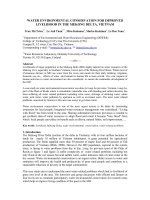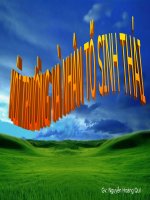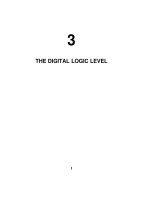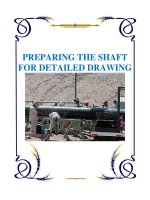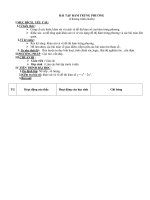- Trang chủ >>
- Khoa Học Tự Nhiên >>
- Vật lý
Tài liệu Open channel hydraulíc for engineers ppt
Bạn đang xem bản rút gọn của tài liệu. Xem và tải ngay bản đầy đủ của tài liệu tại đây (129.9 KB, 9 trang )
OPEN CHANNEL HYDRAULICS FOR ENGINEERS
---------------------------------------------------------------------------------------------------------------------------
-----------------------------------------------------------------------------------------------------------------------------
i
CANTHO UNIVERSITY
MHO 5/6 project
Civil and Mechanical Engineering
OPEN CHANNEL HYDRAULICS
FOR ENGINEERS
LECTURE NOTE
PREPARED BY
LE ANH TUAN
DELFT, 2003
OPEN CHANNEL HYDRAULICS FOR ENGINEERS
---------------------------------------------------------------------------------------------------------------------------
-----------------------------------------------------------------------------------------------------------------------------
ii
To my wife Hoang Nga, my son Anh Tu and my daughter Hoang Ngan,
and all my closed friends ...
You are lovely rivers flowing in my dreams ...
LA. Tuan
OPEN CHANNEL HYDRAULICS FOR ENGINEERS
---------------------------------------------------------------------------------------------------------------------------
-----------------------------------------------------------------------------------------------------------------------------
iii
PREFACE
The subject of Open Channel Hydraulics for Engineers, also called Applied
Hydraulics, is a subject required not only for Hydraulic Engineering students but also
for other engineering fields involved, such as Construction Engineering,
Transportation Engineering and Environmental Engineering. It follows the previous
subject named Fluid Mechanics. The knowledge of open-channel hydraulics, which is
essential to the design of many hydraulic structures, has made advances by leaps and
bounds. The practical importance of this topic in the water resources development
together with the challenge posed by the variety and complexity of its problems, has
created for a long time the need for more comprehensive and detailed treatment of this
subject. As a result, many excellent texts have been written, not only in English, but
also in other languages. The best of these texts have imposed a logical and coherent
structure in the study of the subject, and created a tradition that present texts
consciously follow.
This lecture note is prepared as a reference document for the subject. It emphasizes
the dynamics of the open-channel flow, by attempting to provide a complete
framework of the basic equations of motion of the fluid, which are used as building
blocks for the treatment of many practical problems. The structure of the document,
with seven chapters totally, follows a logical sequence from a description and
classification of Fluid Mechanics and Open Channel Flows, as reviewed in Chapter 1.
A development of the basic equation of motion for uniform flow is encountered in
Chapter 2. Coming to Chapter 3, the fruitful concepts of specific energy and hydraulic
jumps are introduced and developed. Chapter 4 presents a variety of non-uniform
flows and applications of drawing water-surface profiles. Spatially-varied flow, found
at spillways and weirs is considered in Chapter 5. Transitions and energy dissipators
are discussed in Chapter 6. Finally, in Chapter 7, unsteady flow in open channels is
introduced generally and an introduction to the method of characteristics is presented.
Writing on the subject matter of this lecture note, grateful use has been made of the
authoritative texts and treatises on the subject by Ven Te Chow (1973), Henderson
(1966), Sergio Montes (1998) and Hubert Chanson (1999), to which frequent
references were made.
Developing this lecture note is part of the activities within the MHO 5/6 project. This
document could not have been completed without the enthusiastic support and advices
of Professor Dr. Henri L. Fontijn, Head of the Fluid Mechanics Laboratory of the
Faculty of Civil Engineering & Geosciences (CiTG), Delft University of Technology.
He spent numerous hours of his time reading and advising on the typed texts.
Special acknowledgments are due to the faculty and staff members of CiTG, CICAT,
Delft University of Technology and my colleagues at CanTho University, who
encouraged me in many ways.
Finally, I would like to thank all my family members and friends, whose help in
loving support is most gratefully acknowledged.
LE ANH TUAN
Delft University of Technology, the Netherlands, September 2003
OPEN CHANNEL HYDRAULICS FOR ENGINEERS
---------------------------------------------------------------------------------------------------------------------------
-----------------------------------------------------------------------------------------------------------------------------
iv
CONTENTS
Preface ............................................................................................................... iii
Contents ............................................................................................................. iv
List of symbols ................................................................................................... vii
Chapter 1: INTRODUCTION ........................................................................ 1
1.1. Review of fluid mechanics .................................................................... 1
1.1.1. Fluid mechanics .......................................................................... 1
1.1.2. Hydrostatics ................................................................................ 3
1.1.3. Continuity equation ..................................................................... 4
1.1.4. Types of flow .............................................................................. 4
1.1.5. Bernoulli’s equation .................................................................... 5
1.1.6. Euler’s equation .......................................................................... 5
1.1.7. Flow through orifices, mouthpieces and pipes .............................. 5
1.1.8. Flow through open channel .......................................................... 6
1.2. Structure of the course .......................................................................... 7
1.2.1. Objectives of the course ............................................................... 7
1.2.2. Historical note for the course........................................................ 7
1.2.3. Structure of the course.................................................................. 8
1.3. Dimensional analysis ............................................................................. 10
1.3.1. Fundamental dimensions.............................................................. 10
1.3.2. Dimensional homogeneity............................................................ 11
1.3.3. Principles of Dimensional Homogeneity ...................................... 12
1.3.4. Buckingham’s - theorem............................................................ 14
1.3.5. Limitations of dimensional analysis ............................................. 16
1.4. Similarity and models ........................................................................... 16
1.4.1. Advantages of model analysis ...................................................... 16
1.4.2. Hydraulic similarity ..................................................................... 17
1.4.3. Geometric similarity..................................................................... 17
1.4.4. Kinematic similarity..................................................................... 18
1.4.5. Dynamic similarity....................................................................... 18
1.4.6. Technique of hydraulic modelling................................................ 19
1.4.7. Developments in hydraulic model testing..................................... 20
1.4.8. Undistorted models ...................................................................... 20
1.4.9. Comparison of an undistorted model and the prototype ................ 21
1.4.10. Distorted models ........................................................................ 22
1.4.11. Advantages and disadvantages of distorted models..................... 23
1.4.12. Comparison of a distorted model and its prototype..................... 23
Chapter 2: UNIFORM FLOW ....................................................................... 25
2.1. Introduction .......................................................................................... 25
2.1.1. Definition .................................................................................... 25
2.1.2. Momentum analysis .................................................................... 27
2.2. Basic equations in uniform open channel flow ...................................... 28
2.2.1. Chezy’s formula........................................................................... 28
2.2.2. Manning’s formula....................................................................... 30
2.2.3. Discussion of factors affecting f and n.......................................... 32
2.3. Most economical cross-section ............................................................. 32
OPEN CHANNEL HYDRAULICS FOR ENGINEERS
---------------------------------------------------------------------------------------------------------------------------
-----------------------------------------------------------------------------------------------------------------------------
v
2.3.1. Concept ....................................................................................... 32
2.3.2. Conditions for maximum discharge ............................................. 32
2.3.3. Problems of uniform-flow computation........................................ 36
2.4. Channel with compound cross-section .................................................. 38
2.5. Permissible velocity against erosion and sedimentation ......................... 40
Chapter 3: HYDRAULIC JUMP .................................................................... 46
3.1. Introduction .......................................................................................... 46
3.2. Specific energy ..................................................................................... 47
3.2.1. Specific energy ........................................................................... 47
3.2.2. Critical depth and critical velocity ............................................... 48
3.2.3. Types of flows ............................................................................ 49
3.3. Depth of hydraulic jump ....................................................................... 51
3.3.1. Concept ....................................................................................... 51
3.3.2. Water rise in hydraulic jump ....................................................... 51
3.3.3. Energy loss due to hydraulic jump ............................................... 53
3.3.4. Hydraulic jump features .............................................................. 54
3.4. Types of hydraulic jump ....................................................................... 55
3.4.1. Criterion for a critical state-of-flow ............................................. 55
3.4.2. Types of hydraulic jump .............................................................. 58
3.5. Hydraulic jump formulas in terms of Froude-number ............................ 61
3.5.1. Momentum-transfer curve............................................................ 61
3.5.2. Direct hydraulic jump................................................................... 62
3.5.3. The initial depth and the sequent depth ........................................ 62
3.5.4. Energy loss ................................................................................. 64
3.5.5. Efficiency ................................................................................... 66
3.5.6. Height of jump ............................................................................ 66
3.5.7. Length of jump ............................................................................ 66
3.6. Submerged hydraulic jump ................................................................... 67
3.6.1. Definition .................................................................................... 67
3.6.2. Flow in submerged jump ............................................................. 68
Chapter 4: NON-UNIFORM FLOW .............................................................. 70
4.1. Introduction .......................................................................................... 70
4.1.1. General ....................................................................................... 70
4.1.2. Accelerated and Retarded flow .................................................... 71
4.1.3. Equation of non-uniform flow ..................................................... 73
4.2. Gradually-varied steady flow ................................................................ 75
4.2.1. Backwater calculation concept .................................................... 75
4.2.2. Equation of gradually-varied flow ............................................... 75
4.3. Types of water surface profiles ............................................................. 77
4.3.1. Classification of flow profiles ..................................................... 77
4.3.2. Sketching flow profiles ............................................................... 79
4.3.3. Prismatic channel with a change in slope...................................... 82
4.3.4. Composite flow profiles with various controls ............................. 83
4.4. Drawing water surface profiles ............................................................. 84
4.4.1. Direct-step method ...................................................................... 84
4.4.2. Direct numerical integration method ............................................ 88

